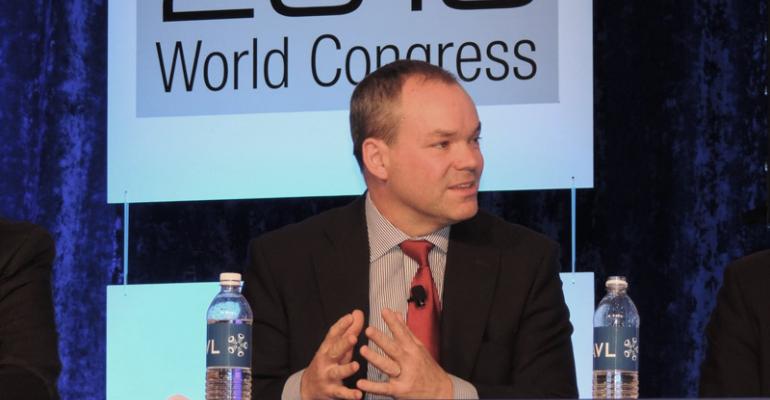DETROIT – Auto makers are surprisingly close to reaching federally mandated fleet fuel economy of 54.5 mpg (4.3 L/100 km) by 2025, but the industry will not achieve the minimum without the important spark of electrification, top powertrain engineers say.
David Johnson, CEO of Achates Power, which markets a fuel-saving opposed-piston-architecture diesel engine for commercial applications, says loopholes in the corporate average fuel economy regulations water down the seemingly insurmountable minimum.
For example, auto makers can use credits from electric vehicles to boost their fleet fuel economy, and the laboratory testing done by regulators to determine vehicle fuel-economy averages typically yield numbers 20% higher than real-world driving.
“Within CAFE there’s a lot of interesting math. So if we wipe all that away, it’s not so far out of reach,” Johnson says during a panel discussion on future powertrain technologies at the SAE World Congress here.
“We have cars today getting 42 mpg (5.6 L/100 km), 45 mpg (5.2 L/100 km), so it’s possible,” he says, predicting some downsizing will be needed to achieve the minimums.
However, the industry’s fleet will require broader electrification in the form of hybrid-electric vehicles, plug-in HEVs and battery EVs, the panelists say. Last year, the technologies combined for 482,570 light-vehicle sales and a 3.3% share of the 14.4 million-unit U.S. market, according to WardsAuto data.
By 2025, federal rule makers expect upwards of 49% of vehicles sold to feature some degree of electrification.
Hakan Yilmaz, chief engineer-gasoline systems at parts supplier Bosch, says larger vehicles will need that technology most.
“When you get to large pickups and luxury-segment vehicles, all will need some sort of solution with electrification,” Yilmaz says. “With conventional-engine solutions, it is a very hard target to reach.”
Christopher Thomas, vice president and chief technical officer at BorgWarner, thinks microhybrids will play the largest role of the three.
“Very mild hybrids are the ones you are going to see out there in the market, because the electrical architecture of the vehicle does not require the safety connectors and (electrical) grounds that add cost to the system,” he says.
The real challenge may not be a technical one, either, offers Guenter Fraidl, senior vice president-powertrain system passenger cars at AVL List.
“It’s a marketing challenge,” he says. “Will people be willing to buy vehicles with high efficiency?”
The panelists express skepticism light-duty diesel and hydrogen fuel-cell technologies will play anything more than minor roles in reaching the standards.
Ford’s Andreas Schamel, director-global powertrain research and advanced engineering, and managing director-European Ford Research Centre, says economics and a checkered past are stacked against widespread adoption of diesel engines in the U.S.
Expressing many of the same thoughts retired General Motors Vice Chairman Bob Lutz shared at SAE this year, Schamel cites the absence in the U.S. of a high-enough gasoline tax to make diesel the cheaper fuel, as it is in Europe. He also points to the diesel engine’s tarnished reputation in the market and the higher cost needed to make the technology meet stricter U.S. emissions requirements.
“All of that combined, I’m skeptical diesel will make it into the low end of the market,” he says, speculating it could be an option for bigger vehicles. “Will we see the same kind success rate in the Focus (C-car) class as in Europe? I don’t think so.”
However, today’s diesels are much different than the smelly, unreliable engines Americans were faced with during the 1980s, says Michael Harpster, director-Propulsion Systems Research Lab, GM Global Research & Development.
GM will bring its first diesel car to market this fall with the ’14 Chevrolet Cruze Clean Turbo Diesel, which the auto maker thinks will be as popular for its performance as its fuel efficiency.
Harpster notes the European boom in diesel installations coincided with dramatic improvements in their performance, making the cars fun to drive.
“We always focus on efficiency, on quantifiable metrics, but (the growth in diesel demand) was really a function of other things. The cars were athletic (and) had lots of low-end torque. It was a good car to buy.”
As for the resurgence in hydrogen FCEV research, such as Ford’s new partnership with Daimler and Renault-Nissan to commercialize a product with the technology by 2017, Thomas calls the gambit a function of future California zero-emissions-vehicle laws. The state will require one in seven vehicles sold in 2025 to be fully zero-emissions or a PHEV.
“It will be part of the pie, but not a very large one,” he says.





